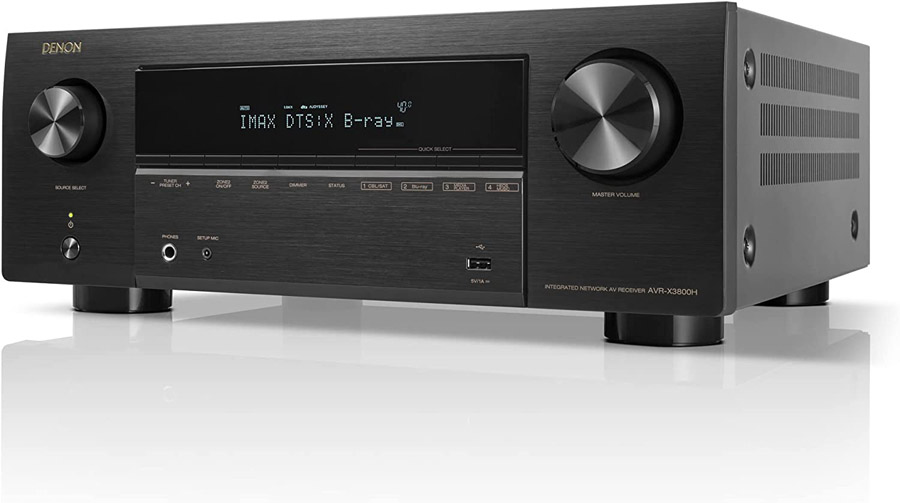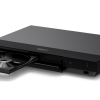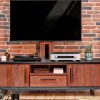In This Article:
The Case for Audio/Video Receivers (AVRs)
While soundbars have come a long way over the years, nothing beats a good Audio/Video receiver (AVR) with a discrete set of surround sound speakers for a truly immersive and cinematic surround sound experience at home. Buyers of modern audio/video receivers get more of everything: more inputs, more features, more flexibility and usually better sound to boot. Yes, it will take you a bit more time (and a roll of speaker wire) to set up, compared to a soundbar. You’ll also need to pair the receiver with a set of passive speakers for surround sound and usually a powered subwoofer (or two) as well, but the sonic rewards you’ll get will be well worth the effort.
Also known as a “home theater receiver,” or “surround sound receiver,” the AV receiver has undergone a bit of a renaissance in the past few years, starting with a flurry of new receiver announcements in 2022 and new models following every year since, from various brands. We saw new models from Masimo’s top receiver brands Denon and Marantz in 2022, and a selection of new receivers offered by Sony in 2023.
Since VOXX International and its subsidiary Premium Audio Company’s acquisition of the Onkyo, Integra and Pioneer brands in 2021, we’ve seen several new models introduced among those brands and, perhaps more importantly, regular firmware updates delivered to existing receivers to fix bugs and offer new functionality months or even years after the initial sale. In late 2024, these receiver brands are changing hands once again with Gentex making an offer for VOXX which is expected to be finalized in 2025. We don’t expect all of the PAC brands to survive long term, but with Onkyo’s history and prominence in the market, we do expect the new parent company to continue investment in and support of that brand.
For 2024, our Editors’ Choice Awards consider receivers released in 2024 as well as those released earlier which are still offered for sale in 2024. All of the A/V receiver models we’re recommending here support video displays up to 8K in resolution, offer ARC and eARC HDMI compatibility, include HDMI 2.1 and HDCP 2.3 support and are compatible with the latest source components including next generation gaming consoles, 4K/8K media players and Ultra HD 4K Blu-ray Disc players. Also, all of our “Editors’ Choice” award-winning receivers support DTS:X and Dolby Atmos immersive surround – not just the “virtual” kind but the discrete kind with real height speakers for the most immersive and enveloping surround sound experience. The minimum requirement for this is seven channels of on-board amplification for a 5.1.2-channel DTS:X or Dolby Atmos speaker system.
Prices listed are MSRP (Manufacturers’ Suggested Retail Price). Check the links for current selling prices on sites such as Amazon and Crutchfield.
Best Budget AVR: Denon AVR-S770H ($599)
The Denon AVR-S770H (available on Amazon) includes all of the features a burgeoning music and movie lover or budget-minded audiophile might crave including Dolby Atmos (5.1.2), DTS:X, six HDMI ports, network streaming and even a turntable input. It includes a reasonably powerful seven channel amplifier (75 Watts/Channel) which is capable of powering a Dolby Atmos 5.1.2-channel speaker system in a small to medium sized living room or home theater.
In late 2023, the S770H replaced our previous budget pick, the AVR-S760H. The newer model offers similar functionality and performance, however it lacks the earlier model’s analog RCA video inputs and output (only relevant if you intend to hook up an old-school VCR or LaserDisc player to your system). The new model also offers an improved user interface to make set-up a bit simpler.
Like the 760H, the AVR-S770H includes support for Denon’s HEOS multi-room music platform and app, so if you’re thinking about putting speakers in multiple rooms, and don’t already have a Sonos system or something comparable, Denon’s HEOS is something to consider.

The Denon receiver is compatible with the top three voice assistant/home control platforms: Amazon Alexa, Google Assistant and Apple Siri. You’ll find Audyssey MultEQ on board for automated speaker level calibration.
It’s worth noting that those searching for a similar offering at a lower price might consider Denon’s earlier AVR-S760H model or the AVR-X1700H, which is quite similar to the AVR-S760H but offers a longer warranty (3 years vs. 2 years) as it’s part of the company’s upgraded “X” line, as opposed to the entry level “S” line. If you can find a deal on either of these older models, you can expect performance and functionality similar to the AVR-S770H.
Pros:
- Low price
- Discrete Dolby Atmos and DTS:X support
- Turntable input
- Six HDMI ports with support for ARC/eARC, HDMI 2.1, HDCP 2.3
Cons:
- Lacks support for IMAX Enhanced
- Cannot be expanded beyond 5.1.2 channels
- Lacks analog video inputs of its predecessor
Where to Buy:
- Denon AVR-S770H A/V Receiver – Amazon
- Other Alternatives:
Best Budget 9-Channel AVR: Onkyo TX-NR7100 ($899)
Although Onkyo’s TX-NR7100 has been on the market since early 2022, it is still current in the company’s line-up and still widely available to purchase online. Also, as recently as December, 2024, the company has delivered free over-the-air software updates to the NR7100, including bug fixes and new features. With the latest update, the NR7100’s built-in Dirac Live room optimization suite offers improved performance and reliability, and existing owners can now enjoy Dolby Atmos music from both Amazon Music Unlimited and TIDAL (with subscription to either service).
With a recent MSRP price drop to $899 (and additional discounts online), the Onkyo TX-NR7100 is now the most affordable nine channel AV receiver from an established name brand. This is a great option for those with a larger home theater space or living room who wish to deploy a 5.1.4 or 7.1.2-channel Dolby Atmos speaker system.

With those nine channels of on-board amplification and a rated 100 Watts/Channel, the TX-NR7100 can fill a large room with immersive surround. You can choose between a 5.1.4 (four height channels) or 7.1.2 (two height channels) configuration, depending on your room size, layout and preferences. Or you can go with a 5.1.2 or traditional 7.1 channel system and use the extra two amplifier channels to power a pair of passive speakers in another room.
What makes the TX-NR7100 receiver special, particularly at its price point, is the inclusion of Dirac’s best of breed room correction software “Dirac Live.” Unlike other brands, Onkyo has included Dirac Live on-board at no extra cost. The room correction routine itself is handled via a dedicated Onkyo app for Android or Apple devices. Seasoned Dirac calibrators and CI professionals can also use Dirac software for Windows to tweak the receiver’s sound even further. Beyond what you can do with standard speaker calibration routines, Dirac Live makes adjustments in both the amplitude and time domain, compensating and correcting for anomalies in your listening room that may impact sound quality.
On the audio decoding and processing front, in addition to Dolby Atmos, Dolby TrueHD, DTS-HD Master Audio and DTS:X, the Onkyo TX-NR7100 includes “IMAX:Enhanced” certification as well. With bi-directional Bluetooth, you can either stream music to the receiver using your phone or stream sound from the receiver to a pair of Bluetooth headphones or earbuds for late night listening.
The TX-NR7100 plays particularly nicely with third parties, including Sonos. The 7100 is “Works with Sonos” certified, which means your living room or home theater system can become its own Sonos room (zone) by adding a Sonos Port. Volume and input switching can then be handled within the Sonos app – no need to grab the Onkyo remote when listening to music.
The receiver also includes native support for multiple streaming music services including Spotify, TIDAL (with Dolby Atmos support), Amazon Music HD (with Dolby Atmos support), Deezer, TuneIn, and Pandora. It is also compatible with the three most popular smart home ecosystems: Apple HomeKit, Google Home and Amazon Alexa. The receiver can be voice-controlled on any of these platforms using a compatible device. The Onkyo receiver supports DTS PlayFi for playback of your local digital music files, compatible apps and synchronization across multiple rooms. Finally, the TX-NR7100 has Google Chromecast on-board and Apple AirPlay 2 support built in.
Pros:
- Dolby Atmos, DTS:X and IMAX Enhanced Support
- Dirac Live room correction built-in (no upcharge)
- Plenty of channels (up to 5.1.4 or 7.1.2 channel immersive sound)
- Plays nicely with 3rd party products
- Dolby Atmos music compatibility in Amazon and TIDAL with free OTA update
- Most affordable 9-channel AVR from a name brand
Cons:
- Dirac Live version lacks independent subwoofer support
- Lacks preamp outputs for channel expansion or future upgrades
Where to Buy the Onkyo TX-NR7100:
Best Lifestyle AVR: JBL MA710 ($799)
We may not normally think of a “Best AVR” competition as a beauty contest, but perhaps audio/video performance and functionality are not the only things to consider when shopping for an A/V Receiver? If AVRs are to compete with soundbars among style conscious buyers, then getting past the “decor police” with an AVR purchase may be something worth considering.

Of course, if you’re paying a CI (Custom Installation) pro to build a system for you, the gear can all be hidden in a closet and the speakers can be built into the wall or ceiling. But if you’re building a simple DIY system which will be on public display in your living room or studio apartment and are looking for something that looks as good as it sounds, then you should check out JVC’s new MA (Modern Audio) series of AVRs. They’re available in an elegant, clean white finish with minimal knobs and buttons and they use a simple remote control featuring only the buttons you’re most likely to need on a daily basis.

The line goes from a basic 5.1 model for $399 up to a full fledged home theater beast with nine channels of built in amplification for $1599. The sweet spot, in our opinion, is the JBL MA710. It offers a super-slim profile, an elegant white finish option and enough amplifier channels for a 5.1.2-channel Dolby Atmos/DTS:X sound system. Match it with a set of JBL Stage 2 speakers in their “Latte” finish for a highly capable Dolby Atmos home theater kit that will pass muster with even the most style-conscious interior decorator or designer.

Rated at 110 Watts/Channel into 2 channels, or 90 Watts/Channel into 7 channels (each into 8 ohms), the MA710 is up to the task of filling a small to medium sized living room or studio with immersive sound. Six HDMI ports should be enough for most people to connect all their sources, but there’s also both analog and digital audio inputs for legacy gear and even a phono input with built-in preamp for a vintage turntable. Also, its flexible configuration options allow the buyer to start simple – with an inexpensive two channel system – and upgrade to a full 5.1.2-channel home theater system adding more speakers over time as budget allows.
eCoustics founder Brian Mitchell and I have each spent some quality time with the MA710 at separate press events listening to music and watching movies in both two-channel and multi-channel configurations. While it isn’t the most dynamic audio performer, the MA710 offers a significant upgrade from soundbar-based systems, even those selling for more. And its elegant aesthetics set it apart from the competition. Brian and I both feel that its unique combination of beauty and brawn earn it a spot in this year’s Editors’ Choice awards roster.
Pros:
- Elegant design should appeal to style-conscious consumers
- Enough power to drive a 5.1.2-channel Dolby Atmos speaker system to reasonably high levels
- Ample inputs to accommodate game consoles, Blu-ray and CD players or even a vintage turntable
- Simple setup and easy-to-use remote
Cons:
- Toward the higher price range for a 7-channel receiver
- Dynamic range a bit limited for home theater
Where to Buy:
Best High-End AVR: Denon AVR-X3800H ($1,699)
First released in 2022, but still a current model, Denon’s AVR-X3800H receiver offers nine channels of on-board amplification with a power rating of 105 Watts/channel (2 channels driven). But unlike the Onkyo TX-NR7100, the Denon AVR-X3800H can be upgraded to an eleven channel system by simply adding a two-channel power amp. The X3800H can even act as a full preamp/processor with all eleven channels output to external power amplifiers if you really need to fill a large space with sound or just want to upgrade the on-board amps.
The AVR-X3800H includes the latest features and technology for future compatibility and covers all the bases for audio and video format support. I’ve been using it in my reference home theater system for over two years now, and have found it to offer excellent sound quality and reliability as well as fairly simple intuitive operation.
The 3800H features Audyssey’s advanced MultEQ XT32 calibration software on board as well as an optional upgrade for Dirac Live room correction. But unlike the Onkyo receiver (and most other A/V receivers on the market today), the Denon AVR-X3800H supports connection of up to four subwoofers, with independent controls for each. This means you can install two, three or even four subwoofers in your listening room and adjust them so they complement each other instead of working against each other. This can allow you to get truly uniform deep bass response anywhere in your room.
We should mention that Dirac offers three add-on options for the AVR-X3800H: limited bandwidth correction ($259), full bandwidth correction ($349) and full bandwidth correction plus bass control ($599). Pricing of the Dirac upgrades is current as of December, 2024.

The AVR-X3800H also has Denon’s HEOS whole home music and streaming platform on-board so it will easily integrate in a multi-room speaker system along with other HEOS devices. Install the HEOS app on your Apple or Android phone, link it up with the receiver, add your music streaming apps and you’re ready to rock.
For immersive surround, the 3800 supports pretty much every 3D audio format known to man (and woman): Dolby Atmos, DTS:X, IMAX:Enhanced, Auro 3D, 360 Reality Audio and MPEG H. For legacy stereo and surround sound content, the receiver includes Dolby Surround, DTS Neural:X and Auro-Matic processing to enhance the immersiveness of the sound. If you’re into 3D audio, in virtually any format, on virtually any streaming service, the Denon AVR-X3800H has got you covered. And the receiver has only gotten better since launch with Dirac Live room correction now available as an optional software update.
Pros:
- Comprehensive immersive audio format support
- Nine channels upgradeable to eleven channels plus 4 subwoofers (7.4.4)
- Audyssey MultEQ XT 32 calibration on-board
- Upgradeable to include Dirac Live Room Correction
- Independent control of up to four subwoofers
Cons:
- A bit pricey
- Dirac Live room correction options cost extra
- No built-in Sonos compatibility or Chromecast built-in support
- Dolby Atmos music requires connection of external streamer like Apple TV 4K or Fire TV stick
Where to Buy Denon AVR-X3800H:
2024 Editors’ Choice Award Winners – Where to Buy:
- Best Budget AVR: Denon AVR-S770H – Amazon
- Best Budget 9-Channel AVR: Onkyo TX-NR7100 on Amazon
- Best Lifestyle AVR: JBL MA-710 on Crutchfield
- Best High-end AVR: Denon AVR-X3800H on Amazon
Related Reading:
- Yes, You CAN Get a Dolby Atmos Home Theater System for Under $1,000
- Dirac is Bringing Its Groundbreaking Room Correction to Denon and Marantz Receivers
- Denon AVR-S760H A/V Receiver Review
- Sony STR-AZ1000ES A/V Receiver Review
- JBL Unveils New MA Series AV Receivers for Consumers
- Hands-On/Ears-On with JBL’s Modern Audio (MA) Receivers and Stage 2 Speakers
- Onkyo TX-RZ30 AVR Offers Nine Channels and Dirac Live
- Your Onkyo, Integra or Pioneer Receiver May Have Just Gotten a Free Upgrade







































Steven
January 5, 2025 at 12:01 am
Please explain your comment “ Dolby Atmos music requires connection of external streamer like Apple TV 4K”
So does that mean I need to play music using Apple Music. On the Apple TV in order to hear the music in Atmos? If not please explain
Thanks!
Chris Boylan
January 11, 2025 at 4:58 am
Not exactly. It means on that receiver you have to connect a separate streaming box like an Apple TV 4K or a Roku stick or an Amazon Fire TV stick – or even a compatible TV with music streaming apps – in order to play back music in Dolby Atmos format. You don’t need Apple Music though and you don’t specifically need an APPLE TV streaming box. You can get Dolby Atmos from Apple Music, TIDAL or Amazon Music Unlimited. It’s your choice. Then use a source connected to the receiver via HDMI like Apple TV, Roku or FireTV to play it back.
There are a few receivers and soundbars (but only a few) that support TIDAL CONNECT with DOLBY ATMOS. In that case, you could load up the TIDAL app on your phone, play a Dolby Music track then use TIDAL CONNECT to play that back in Dolby Atmos on your soundbar or receiver. No additional source device required. But of the ones on this list, I believe only Onkyo supports TIDAL Connect with Dolby Atmos currently.
Hope that helps!